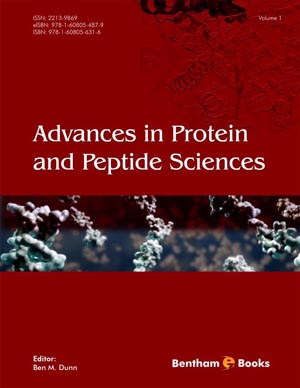Book Volume 10
Organocatalytic α-hydroxylation or α- aminoxylation of Carbonyl Compounds
Page: 1-40 (40)
Author: Armando Talavera-Aleman, Rosa E. del Río, Christine Thomassigny and Christine Greck
DOI: 10.2174/9781681087436118100003
PDF Price: $30
Abstract
α-Hydroxylation or α-aminoxylation of carbonyl compounds in the presence of an organocatalyst has become a significant method for the creation of asymmetric C-O bonds. From the first studies with the classical proline-type or Cinchona-derived organocatalysts, methods have evolved to more efficient systems. Phase-transfer organocatalysts, flow chemistry, ionic liquids, electrochemistry or photo-oxidation permit the reaction with a large range of substrate. While originally aldehydes and ketones were used in these reactions, it is now possible to extend the scope to amides or dicarbonyl compounds such as β-keto ester and β-keto amide. The present review aims to present a general overview of the evolution of these systems.
Achmatowicz Rearrangement Derived Synthons, and their Relevant Bioinspired Chemistry
Page: 41-98 (58)
Author: Grzegorz Grynkiewicz
DOI: 10.2174/9781681087436118100004
PDF Price: $30
Abstract
Among enormous wealth of natural product structural diversity, those containing pyran rings are quite common, since they abound in a pool of primary metabolites as well as among products of sugar transfer biocatalytic processes, which lead to glycosides and glycoconjugates classified as secondary metabolites. Additionally, practically every major biogenetic pathway allows, and often promotes, formation of oxygen heterocycles from polyketides or multiply hydroxylated chain intermediates, by way of 1,5-diol dehydration, lactonization, intramolecular hydroxyl group Michael addition, or an intramolecular epoxide ring opening. A variety of the resulting structures among natural products, which are of interest as prospective leads for medicinal compounds, elicit problems with the substance availability and call for efficient synthetic methods of their preparation. The chapter focuses on a particular rearrangement, featuring ring enlargement of 2-furyl carbinols into pyran-2,3-en- 4- uloses [2H-pyran-3(6H)-ones], known as Achmatowicz rearrangement (Achmatowicz reaction; AR), presenting examples of its scope, utility and efficiency, including remarkable capability for enantioselection in chemo- and biocatalytic preparative procedures. The rearrangement can constitute the key transformation in stepwise syntheses of a variety of O- and N- heterocyclic natural products and their mimics, while its primary products – the unsaturated pyranosuloses, provide versatile glycosylation synthons which practically do not require protecting groups and secure easy access to simple and structurally modified mono- and oligo-saccharides with chosen functions and configurations.
Recent Advances in the Synthesis of N-Glycosyl Compounds
Page: 99-138 (40)
Author: Nuno M. Xavier and Rafael Nunes
DOI: 10.2174/9781681087436118100005
PDF Price: $30
Abstract
N-Glycosyl compounds, analogs of glycosides possessing an N-glycosidic linkage, have attracted much attention as synthetic targets in medicinal chemistry, due to their biological activities. In this chapter, the synthesis of non-nucleosidic Nglycosyl compounds is reviewed. The groups of molecules covered herein include Nglycosylamines/ amides, sulfonamides, hydrazines, phosphoramidates and Nglycosylamino acids, among other related derivatives. Methods for their access, based on the literature from the last 20 years, as well as their relevance as bioactive substances, are focused.
Acidic and Basic Functionalized Ionic Liquid Systems for Advanced Synthesis of Five and Six Membered Nitrogenates Heterocycles
Page: 139-196 (58)
Author: Pinky Gogoi, Susmita Saikia, Arup Kumar Dutta and Ruli Borah
DOI: 10.2174/9781681087436118100006
PDF Price: $30
Abstract
This book chapter describes a brief introduction on acidic and basic functional group tethered ionic liquid systems with various ion-pairs and their utilization as recyclable catalyst/medium in designing sustainable advanced synthetic methods of selected five and six membered nitrogenated heterocycles via one-pot approach.
Mesoporous SBA-15: A Superior Heterogeneous Catalytic Support for Multicomponent Organic Synthesis
Page: 197-247 (51)
Author: Diganta Bhuyan, Mrinal Saikia, Pallab Kumar Saikia and Lakshi Saikia
DOI: 10.2174/9781681087436118100007
PDF Price: $30
Abstract
The design and synthesis of various porous solids have been gaining much attention in recent years owing to their diverse chemistry and widespread application potential in various fields. In particular, the synthesis and functionalization of highly ordered, uniform mesoporous silica based material such as SBA-15 are attaining extensive popularity among researchers due to their fascinating properties. It exhibits very high surface area, high thermal and hydrothermal stability and more importantly it possesses two dimensional hexagonally ordered cylindrical mesochannels that can be used as nano reactors for embedding catalytic species such as nanoparticles, complexes and heteropoly acids etc. The encapsulation/immobilization of these catalytically active species onto SBA-15 can be achieved through functionalization of the surface with various functional groups which creates anchors for capturing these species. The resulting encapsulated materials act as superior catalytic system for various important multicomponent reactions (MCRs). This MCRs approach is an integral part of numerous research efforts involved in the drug development programs to get synthetic targets in expeditious way. Some of the targeted compounds such as dihydropyrimidinones, propargylamines, spiroindolines, β-amino carbonyl compounds etc. have shown their biological activities as drug molecules. Recently, various composite materials of SBA-15 were successfully employed as heterogeneous catalysts for these types of reactions. Reusability and selectivity are the certain advantages of this present catalytic system that makes it superior to the other catalytic system available in the literature. A discussion along with examples of application of SBA-15 composites for MCRs will be described in this chapter.
Introduction
Advances in Organic Synthesis is a book series devoted to the latest advances in synthetic approaches towards challenging structures. The series presents comprehensive reviews written by eminent authorities on different synthetic approaches to selected target molecules and new methods developed to achieve specific synthetic transformations or optimal product yields. Advances in Organic Synthesis is essential for all organic chemists in academia and the industry who wish to keep abreast of rapid and important developments in the field.






















